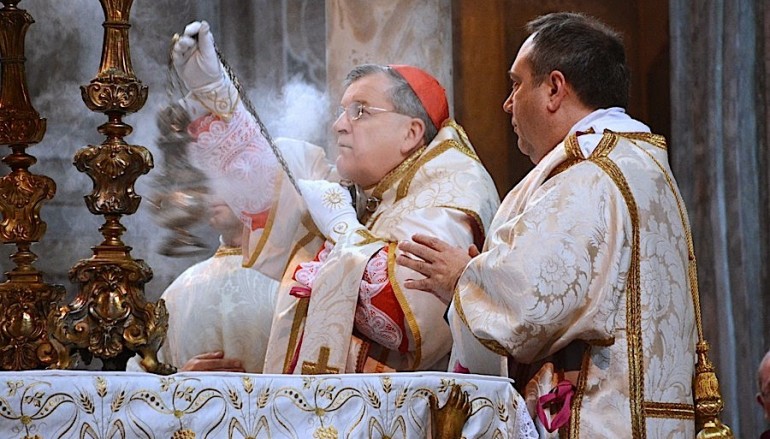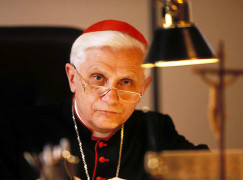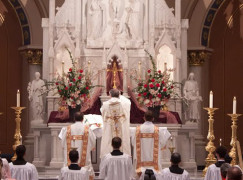

An Open Letter to All Those Looking to Restore a Sense of the Sacred
Written from the Trenches
This past Easter Sunday, a future saint (hopefully) of our Church, Mother Angelica, passed to eternal life. Personally, I believe Mother Angelica, single-handedly, began to turn the Barque of St. Peter around during a time when the Church was moving at breakneck speed into a Moralistic Therapeutic Deism. Much like a loving parent watching her toddler wander out into a road with busy traffic, Mother Angelica was stern and disciplinary in her rebukes of this terribly dangerous trend. As many of her quotes have been shared in the days following Mother’s passing, I was especially struck by this one: “Those who tell the truth love you. Those who tell you what you want to hear love themselves.” In that spirit of honesty, I felt compelled to write the following.
I write as a parish priest in, what I like to refer as, “the trenches.” One could also call it the “front lines.” According to Fr. William Saunders, “The pastor, mindful that he is to exercise his authority as an extension of the bishop and in the example of Christ, the Good Shepherd, must care for the souls of the faithful entrusted to him.”
While pastors are allowed a certain amount of freedom, they remain an extension of the bishop. That means, among many other things, the pastor must remain in concert with the bishop and his desire to build up the body of Christ. Oftentimes, if the people are unhappy with the way in which their pastor is shepherding them, letters flow into the bishop’s office. Or, the people simply shop around for a nearby parish where the priest is “doing it” in the way they wish.
Today, most grievances revolve around the Mass. And, by and large, the grievances have to do with any priest’s efforts to bring the Mass more closely to the “Actual Mass” of Vatican II. While many priests are supported by their bishop in their efforts to move toward the more pure form of the “Mass of Vatican II,” some are not supported, as some bishops find such efforts disruptive, or they simply may not agree with such efforts altogether.
As a result, many priests who truly believe it is necessary for us to restore the Mass and, with this restoration, a greater sense of the sacred, will simply decide it is not worth the repercussions. This is especially stressful for younger priests and seminarians who are receiving a much higher quality formation than we received and, therefore, more clearly understand such a dire need.
EXCEEDINGLY CONCERNED
I count myself among those, priests and lay faithful alike, who are exceedingly concerned with the trajectory of the Catholic Church in America – the actual loss of souls – in this post-Vatican II era.
According to the 2002 Index of Leading Catholic Indicators,
“In 1965, only one percent of U.S. parishes were without a priest. Today, there are 3,000 priestless parishes, 15 percent of all U.S. parishes. Between 1965 and 2002, the number of seminarians dropped from 49,000 to 4,700, a decline of over 90 percent. In 1965, there were 104,000 teaching nuns. Today, there are 8,200, a decline of 94 percent. A 1958 Gallup Poll reported that three in four Catholics attended church on Sundays. A recent study by the University of Notre Dame found that only one in four now attend. Only 10 percent of lay religious teachers now accept Church teaching on contraception. Fifty-three percent believe a Catholic can have an abortion and remain a good Catholic. Sixty-five percent believe that Catholics may divorce and remarry. Seventy-seven percent believe one can be a good Catholic without going to Mass on Sundays. By one New York Times poll, 70 percent of all Catholics in the age group 18 to 44 believe the Eucharist is merely a ‘symbolic reminder’ of Jesus.”
And, if we hoped things were getting any better since this 2002 study, a recent CARA study found that, just since AD 2000, 14 million more Catholics have left the faith, parish religious education of children has dropped by 24%, Catholic school attendance has dropped by 19%, infant baptism has dropped by 28%, adult baptism has dropped by 31%, and sacramental Catholic marriages have dropped by 41%.
Setting aside any debate on the value of the documents of Vatican II, it is clear to any reasonable person that a trend was set in motion, after the council, by so-called leading experts, to make drastic changes in the Church and, most especially, in the Mass. This trend is known by many as the “Spirit of Vatican II,” since these so-called experts could not point to actual writings from the council to justify their innovations and eradications, but simply proclaimed it was implied by a spirit of the documents.
For the most part, the post-Vatican II trend was one that sought to demythologize the faith; to root out any sense of the supernatural or the sacred (most especially, in the Mass). Many see the devastation of the past 50 years as the coup de grâce of a Deism that finds it’s roots in the period of the Enlightenment (see here).
By the time I entered seminary in the 1980s, our training seemed to have an overriding theme: We were called to completely rethink former notions of Catholicism. We seemed to look at our ancestors’ way of believing and practicing their faith much like we would look back at those who believed the world was flat … they meant well, but they just didn’t know any better. This is why it is often referred to as the heresy of “Modernism,” as it looks to erase the old in favor of the new.
For example, we were not offered one minute of Exposition of the Blessed Sacrament in all of my seminary training. Also, it was understood that if someone was seen with a rosary, they would need “extra” spiritual direction (or even psychological counseling), as the rosary raised a red flag of fanaticism. Scripture studies included “explaining away” such miracles as the multiplication of the loaves and fishes as the “miracle of sharing.” Our formation was almost entirely cerebral, with little or no attention to the spiritual or supernatural. Many of the theologians we focused upon during our studies have since been revealed to be heretical.
By the time I was ordained in 1988, my first parish had dropped the title, “Father,” so I was then referred to as “Rick.” It was considered “evolved” if the priests were never seen wearing a roman collar. I spent the first 10 years of my priesthood trying to be cool, and trying to make Catholicism and the Mass hip and “with it.” We would meet with a Liturgy Committee to see what new trendy thing we could insert into the Mass. The Mass was focused on entertainment, and it was focused on us or, worse yet, the priest. I can remember interjecting impromptu comments (ad-libbing) throughout the Mass in order to keep the “experience” casual and whimsical and fun. I used to sing the Eucharistic Prayer like I was Dean Martin. The Mass seemed to resemble a night club act or a Broadway musical. This wasn’t unique to me … it was the common practice of most priests during that era. And, from what I understand, it remains common in many parishes today.
The prevailing underlying thought was that Protestants (particularly, Evangelicals) had it right all along, and we had it wrong. So, our times were considered an era for “fixing that.” All the while, we continued to fall short, as the Evangelical Mega-Churches could do entertainment far better than any average Catholic Church. In attempting to replicate the “entertainment based” worship service of the Evangelicals, ours seemed kitschy, in comparison. As a result, many know that most of the Evangelical Mega-Churches are filled with “former Catholics” … because the entertainment is just “done better there,” so they would believe.
The Point
For I have learnt for a fact that nothing so effectively obtains, retains and regains grace, as that we should always be found not high-minded before God, but filled with holy fear. –St. Bernard
I recently wrote about an epiphany I experienced at a Papal Mass with Pope John Paul II in 1998, when I began to ask myself about what I (we) have been doing until then, “Where, in all of this, was any sense of awe and wonder before God’s supernatural power? Where was the sense of God’s majesty?” Saint Francis of Assisi said, “Man should tremble, the world should quake, all Heaven should be deeply moved when the Son of God appears on the altar in the hands of the priest.” Where was that any longer?
I’ve come to understand that we have, by and large, removed the very gateway into the Divine Life. I agree (and I pray you do too) with Pope St. Gregory the Great who, wanting to capture the spiritual dynamism of the gifts of the Holy Spirit, posited the following order:
“Through the fear of the Lord, we rise to piety, from piety then to knowledge, from knowledge we derive strength, from strength counsel, with counsel we move toward understanding, and with intelligence toward wisdom and thus, by the sevenfold grace of the Spirit, there opens to us at the end of the ascent the entrance to the life of Heaven” (“Homiliae in Hiezechihelem Prophetam,” II 7,7).
As you can see, the entry point into the Divine Life is “Fear of the Lord.” What is Fear of the Lord? According to Fr. John Hardon, Fear of the Lord …
“… inspires a person with profound respect for the majesty of God. Its corresponding effects are protection from sin through dread of offending the Lord, and a strong confidence in the power of His help. The fear of the Lord is not servile but filial. It is based on the selfless love of God, whom it shrinks from offending. Whereas in servile fear the evil dreaded is punishment; in filial fear it is the fear of doing anything contrary to the will of God. The gift of fear comprises three principal elements: a vivid sense of God’s greatness, a lively sorrow for the least faults committed, and a vigilant care in avoiding occasions of sin. It is expressed in prayer of the Psalmist, ‘My whole being trembles before you, your ruling fills me with fear’” (Ps 119:120).
Fear of the Lord, or awe and wonder, is the gateway; this is the trigger that ignites all of the other gifts of the Holy Spirit. This Gift of Awe and Wonder, very simply, transforms the unspiritual man into the spiritual man.
St. Paul writes, “The unspiritual man does not receive the gifts of the Spirit of God, for they are foolishness to him, and he is not able to understand them because they are spiritually discerned” (1 Cor 2:14). The unspiritual man is the person who acts only by using his or her human faculties (intelligence and will) and who therefore can be wise only in the things of the world. He remains superficial and worldly. This is a heart that has hardened to the presence of God. The prophet Jeremiah writes “Cursed is the man who trusts in human beings, who seeks his strength in flesh, whose heart turns away from the Lord. He is like a barren bush in the desert that enjoys no change of season, but stands in a lava waste, a salt land and empty earth” (Jer 17:5-6).
However, throughout the Bible (e.g., Ps 1, Jer 17, Rev 22) we are told that the blessed ones are those who trust God and his ordinances; they are like trees planted beside streams of water. These trees are full of life (their leaves stay green) and they fulfill their purpose (produce fruit) even in the face of life’s challenges. The commentary on 1 Corinthians in the Navarre Bible states, “The spiritual man is the Christian reborn by the grace of God; grace elevates his faculties to enable him to perform actions which have a supernatural value — acts of faith, hope, and charity. A person who is in the state of grace is able to perceive the things of God, because he carries with him the Spirit in his soul in grace, and he has Christ’s mind, Christ’s attitude. ‘We have no alternative,’ St. Josemaria Escriva teaches, ‘there are only two possible ways of living on this earth: either we live a supernatural life, or we live an animal life. And you and I can only live the life of God, a supernatural life’ (Friends of God).”
Surveys by Gallup, the National Opinion Research Center, and the Pew Organization conclude that spiritually committed people are twice as likely to report being “very happy” than the least religiously committed people. Secular analysts seem to be doing back flips trying to explain away the simple reality that there is no other authentic and fulfilling way to live other than a supernatural life; the Divine Life.
Without this initial “trigger” Gift of Awe and Wonder, we are prone to reduce our faith/religion to just another bland organization that has a sense of social responsibility. Jesus is then reduced to an historic figure to emulate. Mass is just a social gathering that many may say (without saying), “It had better have good entertainment if you are going to make me endure this for an hour.” Again, all of the supernatural is stripped out and the belief in miracles and the power of supernatural grace is dismissed as the ignorance of our ancestors (The “flat-earthers” of our faith). We end up with, what I call, a “Stealth Arianism.”
All the while, as this more secular version of Christianity in Western culture has experienced dramatic losses, Christianity in Africa is experiencing a boom. In 1900, there were about 9 million Christians in all of Africa, but today there are upwards of 500 million, accounting for roughly 45% of the total population of the continent. Why? Bishop Robert Barron points specifically to the fact that this is “because the version of Christianity on offer there is robustly supernatural … African Christianity puts a powerful stress on the miraculous, on eternal life, on the active providence of God, on healing grace, and on the divinity of Jesus.”
In America, we are seeing the same kind of increases in sacramental participation and vocations to the priesthood in those dioceses and parishes where they are bucking the trend of a profane and worldly modernism and embracing a traditionalism that fosters a sense of the supernatural; that sees all of the elements of the rich heritage of our Catholic faith as precious jewels to be cherished, rather than old shoes to be discarded.
Borrowing a theme from a recent Star Wars movie, “The Force of Supernatural Grace Must Awaken!” What is needed, first and foremost in our times, is to assist people in breaking through – awakening – to the trigger gift of Fear of the Lord (or Awe and Wonder in God’s Presence). Before this destructive post-Vatican II trend of stripping out of all things sacred, Catholicism led the way in preparing the souls of the faithful to receive this first and most necessary “trigger” Gift of Awe and Wonder through sacred art, sacred architecture, sacred music and special attention to the sacred offering of the Holy Sacrifice of the Mass.
Many believe we simply need to teach more. Teaching is always good. But, as the old adage goes, “You can lead a horse to water, but you can’t make it drink.” In other words, if people are not spiritually inspired to seek such teaching, how can we “force-feed” it to the unspiritual hardened heart? We cannot.
We need to start here by restoring everything that aided the faithful to open themselves to Awe and Wonder before the Lord! We need to help our fellow man tear through the veil of the unspiritual man to the spiritual man, thus enabling him to receive *all* of the Gifts of the Holy Spirit. We cannot even begin to consider a credible and authentic “New Evangelization” without, first, placing our primary focus upon this “gateway gift” of the Holy Spirit.
The Strategy
I wrote in my book, The Church Militant Field Manual,
Any combat training and tactical planning begins with a process of intelligence collection, analysis, and dissemination. Recon (reconnaissance) is a military term used to determine the enemy force’s disposition and intention, gathering information (or intelligence) about an enemy’s composition and capabilities. Dr. Peter Kreeft wrote: “You cannot win a war if you are unwilling to admit we are even at war or you don’t know who your enemy is or you don’t know what strategy your enemy is using.”
We have all witnessed how the dry wind of the enemy’s militant secular propaganda campaign has hardened the hearts of so many of our family members, friends, and neighbors. Spiritually speaking, many have crossed into the dry and lifeless valley of the dry bones prophesied in Ezekiel 37. Dead in their sins, with the rigor mortis of indifference hardening their hearts, they are without the breath of the Spirit, destined for eternal damnation, unless some campaign of search and rescue is launched.
So why has the devil been so effective? What is his strategy? To better understand the tactics of the devil, it is important to understand his names: “diabolos” means “he who places division or separation,” and “daio,” the root of “demon,” means “to divide.” These names identify the two great tactical campaigns the enemy has deployed, especially in recent decades: 1) Cut us off from our (supernatural) supply lines and 2) Divide and conquer.
1) Cut us off from our supply lines – The first major strategy from the father of lies is actually as old as the Garden of Eden itself. It is simply to convince us we do not need God (Gen. 3:5-6), nor do we need His strength and His power (Eph. 6:10). As I said, knowingly or unknowingly, leading figures in the Church, immediately following the Council of Vatican II, set out to de-mythologize our faith, a flat out rejection of the supernatural power of God. Once the devil has us convinced that we can challenge him under our own natural power, or simply deny that he even exists, he’s cut us off from the only real power capable of defeating him: God’s supernatural grace.
Sadly, this secular version of religion has become so prevalent that most people’s eyes begin to glaze over at the mere mention of God’s supernatural grace as a necessary source of power in our lives. St. Peter warns us to be fortes in fide, strong in faith, because the devil prowls around like a lion, looking for someone to devour (1 Pt 5:8-9). Lions size up a herd to find the weakest and easiest target. Once we are detached from God and His supernatural grace, we are powerless to defend ourselves from the tactics of the devil.
Our ancestors and all of the saints knew all about this supernatural power and strength and that being in a state of grace was the armor of God that was to be treasured and protected at all cost. Sacred scripture sees this Divine Life in God (state of grace) as the “hidden treasure” and the “pearl of great price” (Mt 13:44-46).
In his Prayer of Surrender, St. Ignatius of Loyola identifies this as the only meaningful treasure: “Take, O Lord, and receive my entire liberty, my memory, my understanding and my whole will. All that I am and all that I possess You have given me: I surrender it all to You to be disposed of according to Your will. Give me only Your love and Your grace; with these I will be rich enough, and will desire nothing more.”
This is our first and most necessary priority. We simply must put all of our eggs in this basket of restoring a sense of the sacred; a sense of the supernatural. As Pope St. Gregory stated above, it is the first gift; the very “gateway gift” of the Holy Spirit; the Gift of Awe and Wonder.
Therefore, if we are truly serious about evangelization, our attention must be placed on restoring what the Catholic Church once, so beautifully possessed: sacred art, sacred architecture, sacred music and special attention to the sacred offering of the Holy Sacrifice of the Mass. Everything else is just “spinning our wheels,” until we give this the primary attention it requires.
Pope Benedict XVI famously stated, “I am convinced that the crisis in the Church that we are experiencing today is, to a large extent, due to the disintegration of the liturgy.” Building on this, Fr. John Zuhlsdorf speaks often about, “Save the Liturgy, Save the World.” Nothing could be more true, when we consider the fact that the world needs saints, ignited by supernatural grace. And, that it is reverent and sacred Masses that assist the faithful in receiving this first and essential “trigger gift” of the Holy Spirit: The Gift of Awe and Wonder.
Therefore, we must discern, together, how to “save the liturgy.” What does that look like? While I have my own opinions about this restoration, I do not pretend to be among the experts. I will leave those decisions to them. All I know is that I believe something drastic must be done to restore the Catholic Church’s once great aptitude for bringing souls to that first Gift of Awe and Wonder.
Which brings us to the second tactic of the devil, and the necessary strategy to counter it …
2) Divide and conquer – The second modern tactic of the devil is actually the very ancient military strategy of “divide and conquer.” This strategy is defined as one that separates a force that would be stronger if united. As we said, the devil is roaming around like a lion that sizes up the herd to find the easiest target. He is also watching to see who is separated from the herd. Large, coordinated forces are difficult to defeat. If the enemy can separate us into small units or individuals, he can more easily defeat each one.
In 1957, just two years before the call for the Second Vatican Council and the crisis of faith that followed, and just before the revolutionary decade of the 1960s, Sister Lucia (the primary seer at Fatima) said: “The devil is in the mood for engaging in a decisive battle against the Blessed Virgin, as he knows what it is that offends God the most, and in a short space of time will gain for him(self) the greatest number of souls. Thus the devil does everything to overcome the souls consecrated to God, because in this way he will succeed in leaving the souls of the faithful abandoned by their leaders, thereby the more easily will he seize them.”
“Strike the shepherd and the sheep scatter” (Zec 13:7). There’s no doubt that the devil has focused his assault on the religious leaders of our day. While these leaders may have had noble intentions of charity and pastoral sensitivity, the results have been devastating. Decades of lenient, non-confrontational leadership have left the faithful feeble and prone to be “conformed to the pattern of this world” (Rom 12:2). St. Augustine once said, “Charity is no substitute for justice withheld.”
The unfortunate laxity of discipline has permitted confusion and strife where there should be clarity and harmony, an authentic unity based on the truth. As a result, the modern trend among those who believe and teach falsehoods that directly contradict the Church’s teaching is to consider these pockets of dissent as merely “differing tribes” within the Catholic Church. In this deceptive tribal system, those who believe in and teach all that the Church teaches are then considered extreme among these tribes.
Right or wrong, religious leadership seemed to calculate that it is better to refrain from “charged issues” for fear of offending some or even losing members. However, St. Peter Canisius cautioned: “Better that only a few Catholics should be left, staunch and sincere in their religion, than that they should, remaining many, desire as it were to be in collusion with the Church’s enemies and in conformity with the open foes of our faith.”
It is counter-productive if we have “some” parishes looking to restore a sense of the sacred, while others do not. This is a growing phenomenon that only sees parishioners picking and choosing the parish “doing the Mass” the way they like. It’s hard to teach an old dog new tricks. The older we get, the more we tend to stick with “the way we have done it before.” For the most part, we are seeing older adults choosing the modernized version of the Mass because they have grown accustomed to it. In the meantime, young adults find this modern version kitschy and mundane, and many end up leaving the practice of their faith altogether. However, there is growing evidence that, when these younger adults find parishes who are working hard to restore a sense of the sacred, they return to the faith. Younger adults seem more open and drawn to this sense of the sacred that assists them in breaking through to that trigger gift of awe and wonder.
Because of these differences, parishes then end up making their “directional choice” based on “what will attract the most,” rather than what is actually the right thing to do. Since older adults tend to maintain their practice of the faith, most parishes resist losing their parishioners to the neighboring parish by working toward a restoration of the sense of the sacred.
It is time to “rally the troops” … to get on the same page. It’s time to assemble a coalition of leading experts in our time to formulate “the plan” to “Restore a Sense of the Sacred.” There are obvious names that come to mind: Cardinal Burke, Bishop Schneider, Fr. John Zuhlsdorf, and a score of Cardinals, Bishops, priests and laity who understand this critical need in our time; a time that is witnessing a mass exodus from the pews, and is allowing a multitude of souls to be in peril of eternal damnation. It’s time for this coalition to work with Cardinal Sarah, Prefect of the Congregation for Divine Worship and the Discipline of the Sacraments, in designing the plan that all parishes will be instructed to follow.
Is this the first move? One would hope. But, if this call for a coalition would, at first, go unheeded, would that then mean developing a petition to circulate, in order to emphasize the widespread call for such a coalition?
In Conclusion
I wrote this letter as a simple parish priest who laments, day by day, the many souls being swept away by secular trends and fads (inside and outside of our Church), leaving their souls in great peril of eternal damnation. I can’t find it in me to just sit by and allow that to happen, while I am convinced there is, in fact, a solution to save many of these souls. Some find it easy to talk about such things as “the Church does not so much move in years, but in centuries,” as a way to dismiss our need to do anything drastic in our times. While that may be true, I also know that the disintegration of the liturgy and the stripping out of our churches were inflicted, virtually, overnight. Call me a dreamer, but I believe this restoration can occur as quickly as did the disintegration.
Finally, for those who believe such a restoration is too difficult; that such things as sacred music is beyond the talents of most typical parishes, I wanted to share this video of eight teenage girls from rural Wisconsin. They had virtually no professional training. Yes … they were self-taught. They just decided this was important, and proceeded to go about to make it happen.
Where there is a will, there is a way!








